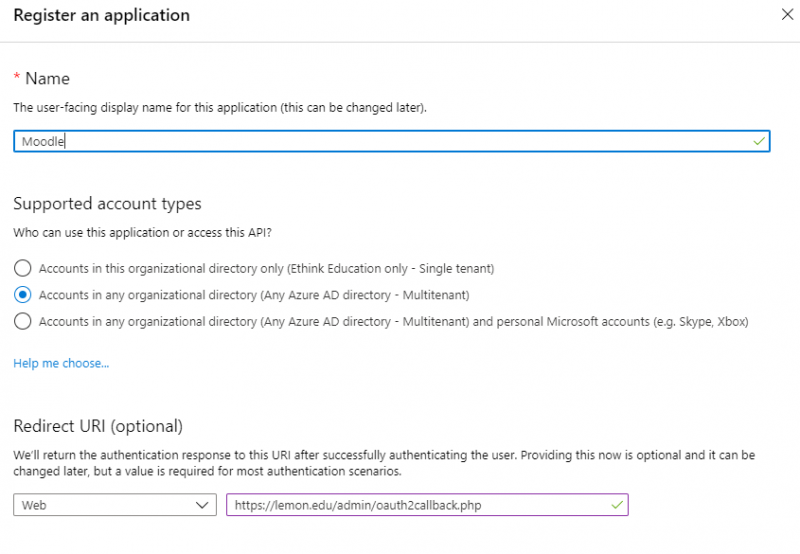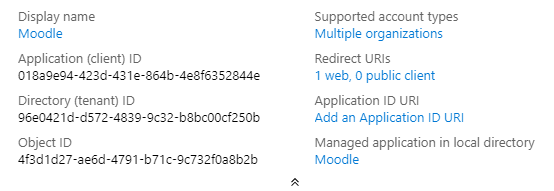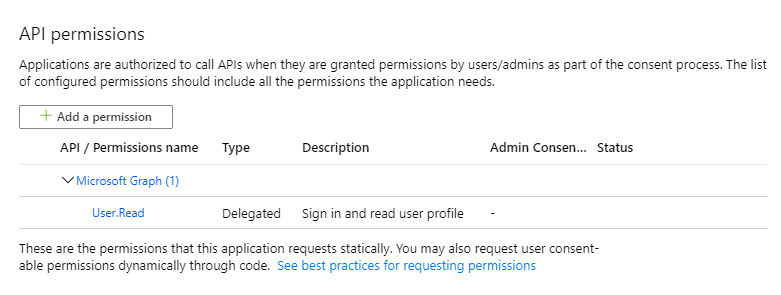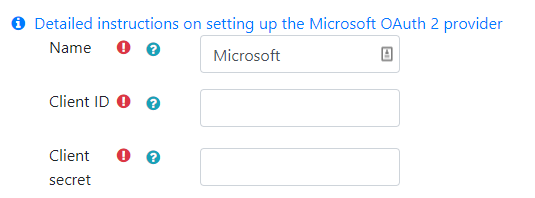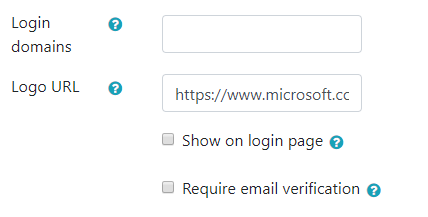Difference between revisions of "OAuth 2 Microsoft service"
(Removed redirect to OAuth 2 Microsoft service) (Tag: Removed redirect) |
|||
| Line 2: | Line 2: | ||
=== Setup App In Microsoft === | === Setup App In Microsoft === | ||
| − | To | + | To set up an OAuth 2.0 client with Microsoft, you must first register a new application by using App registrations in the [https://portal.azure.com Azure Portal]. |
| − | + | 1. From Azure Portal home, under 'Azure services', select 'Azure Active Directory' | |
| − | + | 2. From the left hand menu, select 'App registrations' | |
| − | + | 3. Select 'New registration' | |
| − | + | [[Image:ms_oauth2_2a.png|none|frame|Register new application]] | |
| − | + | 4. Choose a good name as this is what is shown to users when they are asked to approve the permissions. | |
| − | + | 5. For supported account types select 'Accounts in any organizational directory (Any Azure AD directory - Multitenant)'. | |
| − | + | 6. Choose 'Web' for redirect URI and add the callback URL. The callback URL should point to "your Moodle site URL + /admin/oauth2callback.php". If your Moodle site was available at <nowiki>https://lemon.edu/</nowiki> the callback URL would be <nowiki>https://lemon.edu/admin/oauth2callback.php</nowiki>. It is important that your Moodle site uses https and not http. Microsoft will not allow the callback url if it is not using https. | |
| − | + | 7. Click 'Register'. | |
| − | [[File: | + | [[File:ms_oauth2_5.png|none|frame|Application settings]] |
| − | + | 8. Copy the 'Application (client) ID' to a safe place for later use. | |
| − | [[File: | + | [[File:ms_oauth2_6b.png|none|frame|Application (client) ID]] |
| − | + | 9. Select 'Authentication' from side-bar menu. | |
| − | [[File: | + | [[File:ms_oauth2_12.png|none|frame|Authentication]] |
| − | + | 10. Ensure implicit grant flow is disabled. | |
| − | [[File: | + | [[File:ms_oauth2_13.png|none|frame|Disable Implict Grant Flow]] |
| − | + | 11. Select 'API permissions' from side-bar menu. | |
| + | |||
| + | [[File:ms_oauth2_6.png|none|frame|API permissions]] | ||
| − | + | 12. Make sure the "Microsoft Graph (1)" permissions section contains the "User.Read" permission. | |
| − | + | [[File:ms_oauth2_7.png|none|frame|Microsoft Graph]] | |
| − | [[File: | + | 13. Select 'Certificates & secrets' from side-bar menu. |
| + | |||
| + | [[File:ms_oauth2_8.png|none|frame|Certificates & secrets]] | ||
| + | |||
| + | 14. Click 'New client secret' to create password/client secret. | ||
| + | |||
| + | [[File:ms_oauth2_9.png|none|frame|New client secret]] | ||
| + | |||
| + | 15. Add a description and select when the password/secret will expire. | ||
| + | |||
| + | [[File:ms_oauth2_10.png|none|frame|Add a client secret]] | ||
| + | |||
| + | 16. Copy the secret string value to a safe place for later use. | ||
| + | |||
| + | [[File:ms_oauth2_11.png|none|frame|Secret string value]] | ||
| + | |||
| + | 17. In Moodle go to OAuth2 services (Site administration > Server > OAuth2 services) and create a new Microsoft service. | ||
| + | |||
| + | [[File:ms_oauth2_16.png|none|frame|Create new Microsoft service]] | ||
| + | |||
| + | 18. Update the name if desired and enter the password/secret as the "Client secret" and the Application ID as the "Client ID". | ||
| + | |||
| + | [[File:ms_oauth2_14.png|none|frame|Add client ID and secret]] | ||
| + | |||
| + | 19. Make any additional configuration changes such as limiting login domains, whether a login button will show on the login page, and if email verification is required. | ||
| + | |||
| + | [[File:ms_oauth2_15.png|none|frame|Addtional settings]] | ||
==See also== | ==See also== | ||
Latest revision as of 14:52, 11 June 2021
Setup App In Microsoft
To set up an OAuth 2.0 client with Microsoft, you must first register a new application by using App registrations in the Azure Portal.
1. From Azure Portal home, under 'Azure services', select 'Azure Active Directory'
2. From the left hand menu, select 'App registrations'
3. Select 'New registration'
4. Choose a good name as this is what is shown to users when they are asked to approve the permissions.
5. For supported account types select 'Accounts in any organizational directory (Any Azure AD directory - Multitenant)'.
6. Choose 'Web' for redirect URI and add the callback URL. The callback URL should point to "your Moodle site URL + /admin/oauth2callback.php". If your Moodle site was available at https://lemon.edu/ the callback URL would be https://lemon.edu/admin/oauth2callback.php. It is important that your Moodle site uses https and not http. Microsoft will not allow the callback url if it is not using https.
7. Click 'Register'.
8. Copy the 'Application (client) ID' to a safe place for later use.
9. Select 'Authentication' from side-bar menu.
10. Ensure implicit grant flow is disabled.
11. Select 'API permissions' from side-bar menu.
12. Make sure the "Microsoft Graph (1)" permissions section contains the "User.Read" permission.
13. Select 'Certificates & secrets' from side-bar menu.
14. Click 'New client secret' to create password/client secret.
15. Add a description and select when the password/secret will expire.
16. Copy the secret string value to a safe place for later use.
17. In Moodle go to OAuth2 services (Site administration > Server > OAuth2 services) and create a new Microsoft service.
18. Update the name if desired and enter the password/secret as the "Client secret" and the Application ID as the "Client ID".
19. Make any additional configuration changes such as limiting login domains, whether a login button will show on the login page, and if email verification is required.
See also
- OneDrive repository
- OAuth 2 authentication for enabling users to log in to Moodle with their Microsoft account

